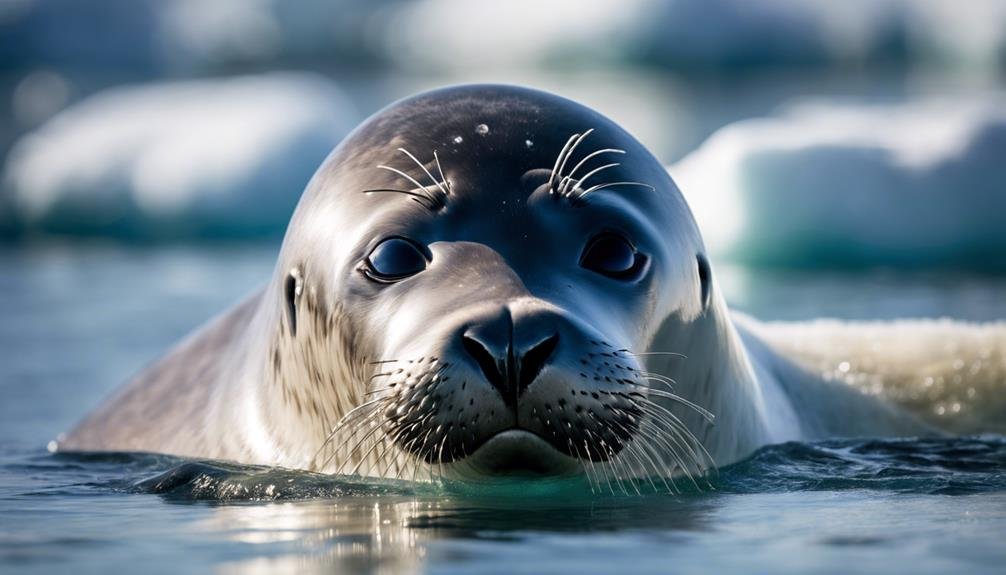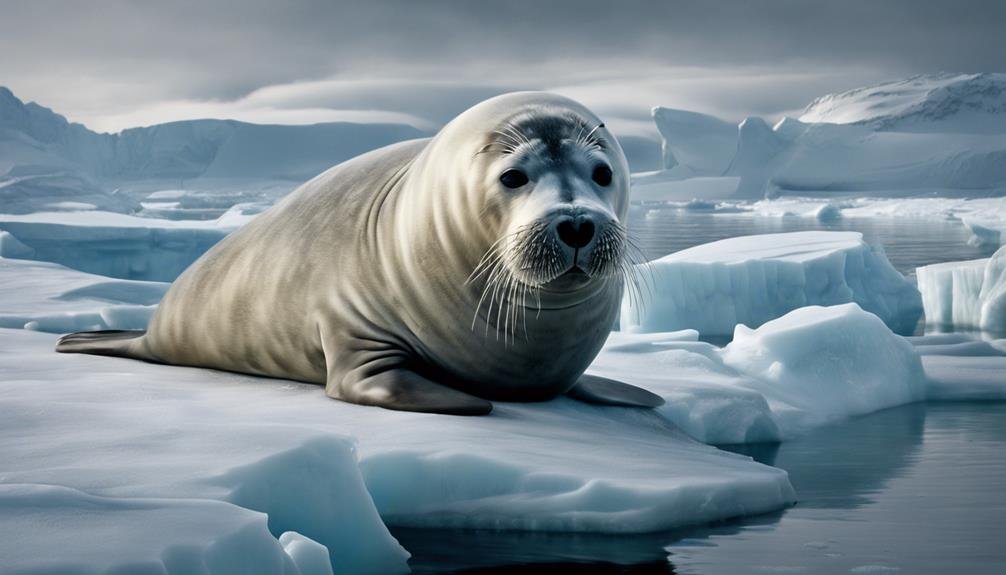Have you ever wondered about the fascinating adaptations of Arctic seals to survive in harsh environments? These incredible creatures have evolved unique features to thrive in the icy expanses of the Arctic. From their insulating blubber and thick fur to their specialized abilities for navigating frigid waters, Arctic seals are truly masters of their environment.
Arctic seals have developed a thick layer of blubber and fur that act as insulation against the extreme cold, allowing them to maintain their body temperature in freezing conditions. Their streamlined bodies and webbed feet enable them to move effortlessly through the water, making them efficient hunters.
Blending in with their surroundings is another crucial adaptation of Arctic seals, helping them evade predators such as polar bears and orcas. Their camouflaged fur allows them to hide on ice floes, while their sleek bodies help them navigate the icy waters unseen.
Remarkably, Arctic seals can hold their breath for extended periods, thanks to their adapted respiratory system. This enables them to dive deep in search of food, such as fish and squid, while avoiding detection from predators.
In conclusion, the adaptations of Arctic seals showcase the incredible ways in which nature has equipped these animals to thrive in one of the harshest environments on Earth.
Key Takeaways
Arctic seals possess specialized adaptations for thriving in the harsh Arctic environment. Their adaptations include insulating blubber and thick fur, streamlined bodies for efficient swimming, and large dark eyes for underwater vision. These unique traits showcase their resilience and ingenuity in facing extreme conditions in frigid Arctic waters.
Insulating Blubber and Thick Fur
Arctic Seals’ Insulating Adaptations
Arctic seals possess a unique adaptation known as blubber, a thick layer of fat beneath their skin. This blubber acts as a natural insulator, effectively keeping the seals warm in the freezing waters of the Arctic. Not only does it help in maintaining their body temperature, but it also provides buoyancy for effortless swimming. This specialized feature allows Arctic seals to conserve energy and thrive in their icy habitat.
Thick Fur: Nature’s Protective Coat
Another crucial adaptation of Arctic seals is their thick fur, which plays a vital role in protecting them from the harsh Arctic conditions. Particularly important for young pups, the fur traps a layer of air close to their skin, offering additional insulation and warmth. This protective coat shields the seals from the frigid waters, enabling them to withstand the extreme cold and harsh environment of the Arctic.
Survival in the Icy Realm
With their remarkable insulating blubber and thick fur, Arctic seals have evolved to thrive in the icy realm of the Arctic. These adaptations not only help them survive the extreme cold but also showcase their remarkable resilience in one of the harshest environments on Earth. By leveraging these natural defenses, Arctic seals can navigate the frigid waters and secure their place in the intricate web of Arctic life.
Streamlined Body for Efficient Swimming
Efficient Swimming with a Streamlined Body
1. Tapered Ends for Reduced Water Resistance
Arctic seals possess a streamlined body with tapered ends that help minimize water resistance. This sleek design allows them to glide smoothly through the water, enhancing their swimming efficiency.
2. Hydrodynamic Structure for Swift Navigation
The hydrodynamic design of Arctic seals’ bodies enables swift navigation and agile movements while hunting. This unique body structure aids in their ability to maneuver quickly and efficiently in the water.
3. Energy Conservation for Optimal Swimming Capabilities
Streamlined bodies of Arctic seals help conserve energy during long migrations and deep dives, optimizing their swimming capabilities for various tasks. This energy-efficient design is essential for their survival in the challenging Arctic environment.
Large, Dark Eyes for Underwater Vision

Arctic Seals: Masters of Underwater Vision
Adaptation for Underwater Vision
Arctic seals have large, dark eyes specially adapted for clear underwater vision. Their eyes are equipped with a spherical lens that helps them see with precision in the dimly lit Arctic waters. This unique adaptation allows them to focus light onto the retina, enhancing their ability to spot prey even in murky conditions.
Mobile Pupil for Light Adjustment
One remarkable feature of Arctic seals’ eyes is their mobile pupil, which can adjust to varying light levels. This capability ensures that they’ve optimal vision both above and below the water’s surface. The ability to adapt their pupil size contributes to their success in hunting and navigating the challenging Arctic marine environment.
Effective Prey Localization
Thanks to their specialized eyesight, Arctic seals can effectively locate and capture prey in the frigid Arctic seas. Their exceptional vision plays a crucial role in their survival, enabling them to thrive in the depths of the ocean where other predators may struggle.
Specialized Breathing Adaptations
Arctic Seals: Masters of Underwater Survival
Blubber Insulation: Arctic seals boast a thick layer of blubber that serves as a vital insulator, keeping them warm and conserving energy during their deep dives.
Efficient Lung Design: These incredible creatures have lungs equipped with specialized structures, such as alveoli, that optimize gas exchange efficiency. This design enables them to stay submerged for extended periods without the need for frequent resurfacing.
Enhanced Vision: With their large eyes and adaptable pupils, Arctic seals have excellent vision both above and below the icy waters. This visual acuity aids them in navigating their environment with precision and ease.
These remarkable adaptations work in harmony to equip Arctic seals with the tools they need to thrive in the challenging Arctic marine habitat, allowing them to effortlessly explore the depths and glide through the frigid waters.
Camouflaged Fur for Protection

Adaptive Fur Coloration for Concealment
Arctic seals possess a remarkable adaptation in the form of their camouflaged fur, specifically designed to aid in their survival in the icy waters. This specialized fur, ranging from white to light gray, serves a crucial purpose in providing protection from predators and enhancing their hunting strategies.
Seamless Blending with Surroundings
The camouflaged fur of Arctic seals allows them to blend seamlessly with their icy surroundings, making it challenging for predators like polar bears and orcas to spot them. This natural disguise plays a key role in increasing their chances of evading detection, ultimately helping them stay hidden and safe.
Enhanced Hunting Efficiency
In addition to protection from predators, the camouflaged fur of Arctic seals also contributes to their hunting efficiency. By remaining inconspicuous in the icy waters, these seals can effectively ambush their prey and secure food resources with greater success. This adaptation gives them a competitive edge in the harsh Arctic environment.
Vital Role in Survival
Frequently Asked Questions
What Are 5 Adaptations of a Seal?
Q: What is the purpose of blubber in seals?
A: Blubber in seals acts as insulation to keep them warm in cold Arctic waters.
Q: How do seals stay warm in the Arctic?
A: Seals have thick fur coats that help regulate their body temperature and keep them warm in harsh environments.
Q: Why do seals have streamlined bodies?
A: Seals have streamlined bodies to swim efficiently in the water, allowing them to move swiftly and catch prey.
Q: What is the function of thick fur coats in seals?
A: Thick fur coats in seals help regulate their body temperature and provide insulation in cold Arctic waters.
Q: How do seals adapt to survive in harsh environments?
A: Seals rely on a combination of blubber insulation, streamlined bodies, and thick fur coats to thrive in the Arctic and other harsh environments.
What Are Common Seal Adaptations?
Q: What adaptations help Arctic seals survive in their environment?
A: Arctic seals survive in their icy environment thanks to blubber insulation for warmth and camouflaged fur for protection. Their impressive hunting techniques and social behavior also play a crucial role in their survival. Furthermore, their diving abilities and communication skills help them thrive in the harsh Arctic conditions.
What Are the Adaptations of Snow Seals?
What are the key adaptations of snow seals?
Answer: Snow seals have blubber insulation, thick fur, and camouflage coloring to thrive in frigid waters. Their fur sheds annually, impacting heat retention. They possess streamlined skin for efficient swimming and large eyes for enhanced hunting vision.
What Physical Adaptations Allow Seals to Survive in Cold Waters?
What physical adaptations help seals survive in cold waters?
Seals survive in cold waters due to blubber insulation for warmth, streamlined bodies for efficient swimming, and unique hunting techniques. These adaptations make them well-suited for Arctic environments.
What Are the Key Survival Strategies That Enable Arctic Seals to Thrive in Harsh Environments?
Arctic seals face extreme cold and limited food availability, yet they thrive due to their remarkable arctic seal survival adaptations. Their thick blubber insulates against freezing temperatures, while streamlined bodies make them efficient hunters. Additionally, their ability to slow heart rates while diving conserves oxygen, allowing them to access deeper, nutrient-rich waters.
Conclusion
To sum up, Arctic seals exhibit a range of specialized adaptations that enable them to thrive in the harsh Arctic environment. These adaptations include insulating blubber and thick fur, streamlined bodies for efficient swimming, large dark eyes for underwater vision, specialized breathing mechanisms, and camouflaged fur for protection.
These unique traits highlight the remarkable resilience and ingenuity of these marine mammals in facing the extreme conditions of the frigid Arctic waters.


